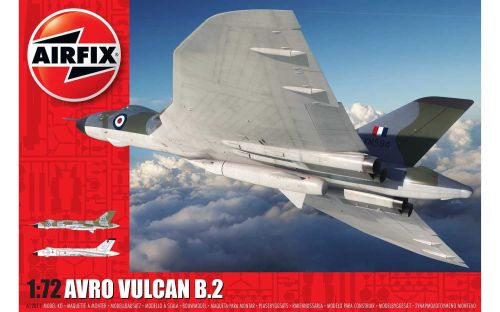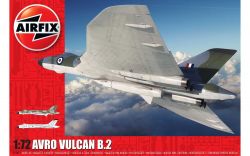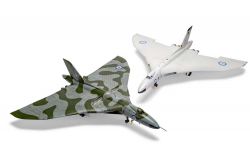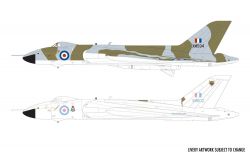This is a preview of the sparkle site, we are not quite ready to take orders.
Delivery
Returns
Avro Vulcan B2 Aeroplane - Scale 1:72 Model Kit - Airfix - A12011 - NEW RELEASE
Read More
Product description
Avro Vulcan B2 Aeroplane - Scale 1:72 Model Kit - Airfix - A12011 - NEW RELEASE
Tech Specs Item Length - Without Packaging (cm) 45 Item Height - Without Packaging (cm) 11.22 Item Width - Without Packaging (cm) 47 How many pieces will be found in the box opened by the customer? 277 Item Scale 1:72 Scale License line BAE SYSTEMS is a registered trade mark of BAE Systems plc. Contents (what's in the box) sets Sprues & decals Finish Plastic Number of Scheme options 2 Skill Level 3 Flying Hours 4 Wingspan (mm) 470Occupying a significant position in the history of post war British aviation, the Avro Vulcan was without doubt one of the most distinctive aircraft ever to take to the skies, with its huge delta wing profile becoming almost as iconic as the elliptical wing of the Supermarine Spitfire. Built to satisfy an extremely demanding Air Ministry requirement for a fast, high altitude strategic bomber, capable of carrying a special payload of 10,000 imperial pounds in weight (a nuclear device), the new aircraft was intended to serve as an airborne deterrent to any future military threat against the UK, with the required specifications representing a 100% increase in the capabilities of any previous British bomber aircraft. When the Vulcan made its maiden flight in August 1952, the Avro team were well on the way to presenting the Royal Air Force with not only the worlds first delta bomber, but also one of the worlds most effective strike bombers.
Interestingly, all this was achieved just nine years since the Avro Lancasters of RAF No.617 Squadron had launched their famous raid against the great dams of the Ruhr Valley. As the Avro Vulcan entered squadron service with No.83 Squadron at RAF Waddington in July 1957, Britain now possessed the fastest nuclear capable bomber in the world. It seems strange to describe an aircraft which possessed such potential for untold destruction as Britains most effective peace keeping asset, however, that is exactly what the Vulcan turned out to be. Throughout the aggressive posturing of the Cold War, the Warsaw Pact nations were in no doubt that if they dared to launch an attack against a NATO member country, the consequences of the inevitable retaliatory strike would be catastrophic. Without Doubt, during the early years of its service career, nothing represented this doomsday scenario more effectively than the mighty Avro Vulcan.
As the Royal Air Force exhaustively trained their new Vulcan crews to provide Britain with an effective Quick Reaction Alert strike force, Avro engineers were already working to improve the capabilities of their original, iconic design. In order to ensure the aircraft continued to maintain its effective deterrent threat and stayed one step ahead of advances in Easter Bloc fighter and surface-to-air missile technology, designers incorporated developments which endowed the aircraft with greater range, speed and altitude performance. The installation of more powerful versions of the Vulcans Bristol Olympus engines would result in a number of unforeseen stability issues with these first bombers, which concerned designers enough to necessitate a re-design of the original wing shape.
By the time the definitive B.2 variant of the Vulcan entered service, the aircrafts wing area had increased significantly and although still classed as a delta, would look quite different from the first bombers which entered service. To cope with the increased power availability from subsequent engine upgrades and to cure the instability issues of the original straight wing design, the B.2 wing had two defined kinks in its leading edge, well forward of the profile of the original wing design. Rather than detract from the pleasing aesthetics of the early Vulcans delta wing, the B.2 actually enhanced the profile of the aircraft and even though these changes were obviously made for reasons of operational effectiveness, as opposed to appearance, the B.2 would go on to be considered the most famous (and most numerous) of all the RAFs Vulcans. The service introduction of the Vulcan B.2 in July 1960 coincided with the availability of more capable nuclear weapons for the V-bomber force, both in number and destructive potential. It would also bring about a change in thinking regarding the delivery of such weapons, as significant advances in Soviet anti-aircraft technology now threatened the success of a free-fall gravity bomb mission. A significant new weapon would have to be developed in order to maintain the deterrent threat of the Vulcan and its V-bomber partners.
Developed to maintain the validity of Britain's nuclear deterrent threat, designers at Avro produced the powerful Blue Steel air-launched, nuclear stand-off missile, which would allow V-bomber crews to launch their attacks 100 miles away from their intended target and out of the range of Soviet surface-to-air missile batteries, allowing crews valuable additional time to avoid the resultant blast. Further boosting the effectiveness of the V-bomber force, the arrival of Blue Steel raised the nuclear stakes in Britains favour once more and would have caused much consternation amongst the Warsaw Pact nations.
The responsibility of providing Britain's strategic nuclear deterrent passed to the submarines of the Royal Navy in July 1969 and saw the RAF performing its final V-bomber Blue Steel mission late the following year. Although taking on a more conventional strike role, RAF Vulcans would retain a nuclear capability and maintain their position as one of the worlds most effective bombers for the next fourteen years, before finally being withdrawn from service. Due to the affection in which this aircraft was held by the British public, the Vulcan Display Flight was almost immediately formed to operate one aircraft on the UK Airshow circuit for a further nine years, before itself being disbanded.
To the amazement of the historic aviation world, the last flying Avro Vulcan, XH558, the aircraft which had previously served as the Vulcan Display Flight aircraft, triumphantly returned to the air once more, this time in the hands of a civilian organisation in October 2007. Over the course of the next eight years, the Vulcan thrilled millions of people around the country, becoming something of an aviation national treasure a relic of the Cold War which was held in great public affection.
Delivery & returns
Delivery
Standard Delivery costs £3.99 to UK mainland only (excluding Scottish Highlands & Islands). Delivery within 3-5 working days once despatched. Orders placed after 12 noon will be despatched the next working day. Delivery service used is either Royal Mail Tracked 48, Royal Mail 2nd Class or Parcelforce 48. Safe place option available. Please note this is not a guaranteed service.
Express Delivery costs £5.99. Delivery within 1-2 workings days once despatched. Orders placed after 12 noon will be despatched the next working day. Delivery service used is Royal Mail Tracked 24. Safe place option available. Please note this is not a guaranteed service.
Packaging
We as a company try to recycle packaging as much as possible. This includes delivery boxes and filling. So please be aware your products maybe packaged on arrival in a recycled box as we are just trying to help the environment a little bit.
Click here to read Sparkle's Delivery Policy
Returns
If you've changed your mind about keeping your purchase, please return it in its original condition with proof of purchase (delivery note or Invoice) and we'll exchange or refund it. Please email returns@giftenvy.co.uk if you wish to return an product, by return email you will receive a returns form to include in your parcel.
Unless faulty, this should be within 30 days of receiving your order. By original condition, we'd expect this to mean that you've kept packaging and labels, and that the item is unused and undamaged.
Buyer to pay return postage costs. We recommend that you obtain a certificate of postage with adequate insurance from the Post Office if making a return, to enable you to make a claim for any loss or damage, as we are unable to compensate for return parcels that are lost or damaged in transit.
Return address:
Gift Envy, Returns, Village Farm Business Park, Foston on the Wolds, Driffield, East Yorkshire, YO25 8BJ
Once the item has been returned in it's original condition a full refund (excluding postage & packaging costs) will be processed within 14 days of receiving the item.
Faulty Items
All faulty items must be reported within 5 days of receiving the item, by emailing returns@giftenvy.co.uk
You will then receive by email a returns form to be fill in and included in the parcel, plus a pre-paid returns label to be attached to the parcel. This can then be dropped off at any post office. Please retained your proof of postage.
Damaged in Transit
All items that have arrived damaged must be reported within 3 days of receiving the item, by emailing returns@giftenvy.co.uk. Please include pictures of the damage, the packaging used and the box it arrived in. By return email you will be advised if a refund will be issued or a replacement sent and arrangements made for the damaged item.
Refund Policy
If you’ve changed your mind about keeping your purchase, please return it in its original condition with proof of purchase and we’ll exchange or refund it.
Unless faulty, this should be within 30 days of receiving your order. By original condition, we’d expect this to mean that you’ve kept packaging and labels, and that the item is undamaged and unused.
Once returned, we’ll refund the person who originally placed and paid for the order, by the same means the order was placed with within 14 days. This includes items you've purchased in Clearance events.
Terms & Conditions
- If you've changed your mind about keeping your purchase, please return it in its original condition with proof of purchase and we'll exchange or refund it
- Unless faulty, this should be within 30 days of purchase
- Ordinarily if you have your receipt or delivery note we'll refund the original debit, credit or charge card used to purchase. This includes items you've purchased in sale events
Please return any unwanted item, unless faulty, in its original condition. We'd expect this to mean that:
- you've kept all original packaging and labels
- it's undamaged and unused (excludes normal examination of the product as you might do in store)
- you haven't entered any personal data on to the product
This does not affect your statutory rights.





